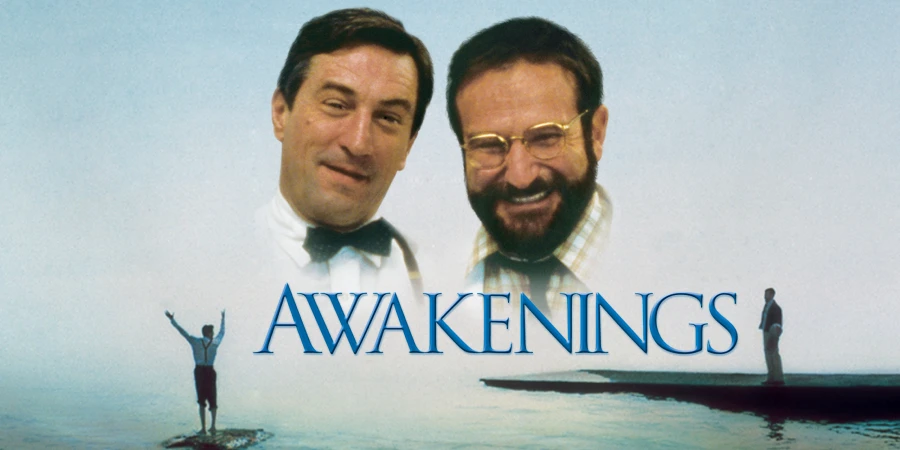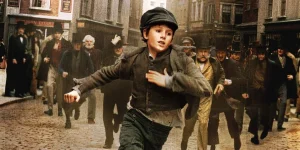Awakenings (1990) is a deeply emotional and thought-provoking drama directed by Penny Marshall, based on the memoir by neurologist Oliver Sacks. It explores themes of human resilience, the fragility of life, and the power of connection. Robin Williams and Robert De Niro deliver career-defining performances that elevate the already poignant story to something unforgettable.
Table of Contents
ToggleDetailed Summary
Introduction: A Doctor’s Curiosity
Set in 1969, Awakenings follows Dr. Malcolm Sayer (Robin Williams), a shy and introverted neurologist who takes a job at a psychiatric hospital in the Bronx. The patients there are in catatonic states, the result of a mysterious illness that followed an epidemic of encephalitis lethargica (sleeping sickness) decades earlier.
Dr. Sayer, who is more familiar with lab work than human interaction, begins noticing that these patients—who appear completely unresponsive—show subtle signs of awareness. One such sign is that they catch objects rather than let them fall, or react to specific stimuli. This leads him to believe that they are not entirely “gone.”
The Discovery of L-DOPA
Driven by both scientific curiosity and empathy, Sayer hypothesizes that a drug used to treat Parkinson’s disease—L-DOPA—might “awaken” these frozen patients. He gets permission to try the drug on a patient named Leonard Lowe (Robert De Niro), who has been catatonic for 30 years.
In a powerful and emotional scene, Leonard awakens. He is fully aware of the time lost, but mentally he is still a man with the dreams and passions he had before falling ill. Encouraged by Leonard’s miraculous progress, Sayer begins administering L-DOPA to the other patients—who all begin to “wake up.”
The Joy and Tragedy of Being Awake
The hospital comes alive with patients experiencing the world again after decades. Leonard enjoys newfound freedom, friendship, and even flirts with romance—particularly with a visitor named Paula (Penelope Ann Miller). Meanwhile, Dr. Sayer begins to break out of his shell, forming deeper connections, especially with Eleanor (Julie Kavner), a nurse at the hospital.
However, not all is well. Leonard becomes increasingly agitated, frustrated with the limitations of his condition and the strict hospital rules. As he pushes for more independence, he also begins to exhibit uncontrollable tics and jerks—early signs that the effects of L-DOPA may not last.
The Inevitable Decline
Soon, Leonard’s condition begins to deteriorate. Despite increasing the dosage, the effects become erratic, and he begins to revert to his former catatonic state. The other patients follow the same pattern—one by one, they lose their newfound freedom. Sayer is devastated, but Leonard asks him to film his decline, hoping the footage will help others in the future.
Movie Ending
The final act of Awakenings is emotionally devastating but deeply human. Leonard, fully aware of his fate, chooses to face it with grace and dignity. In one of the most powerful scenes, he asks Dr. Sayer to dance with him—though his movements are jerky and uncoordinated, the gesture is heartbreaking.
Eventually, Leonard returns fully to his catatonic state. Dr. Sayer, profoundly affected, addresses the patients’ families and the hospital board, explaining that while the awakenings were temporary, they proved that these patients were alive and conscious all along. They weren’t forgotten relics of a disease— they were people, with hopes, dreams, and identities.
The film ends with Dr. Sayer himself “awakening” in a metaphorical sense—he begins to live more fully, opening up to relationships and life beyond the hospital. He and Eleanor go out for coffee, something he had long been too shy to do—suggesting that while the patients’ awakenings were temporary, their impact was lasting.
It’s a bittersweet conclusion: the experiment failed medically, but succeeded profoundly in terms of human connection and understanding.
Are There Post-Credits Scenes?
No, Awakenings does not have any post-credits scenes. The film ends on a reflective note, and the credits roll without additional content or teases. It’s a self-contained story that doesn’t rely on extended universe elements or epilogues.
Type of Movie
Awakenings is a biographical drama based on true events. It leans heavily on emotional storytelling, medical ethics, and human psychology rather than action or high-concept science. This is a film for those who appreciate deep character studies and emotionally resonant narratives.
Cast
- Robin Williams as Dr. Malcolm Sayer
- Robert De Niro as Leonard Lowe
- Julie Kavner as Eleanor Costello
- Penelope Ann Miller as Paula
- Max von Sydow as Dr. Peter Ingham
- John Heard as Dr. Kaufman
Film Music and Composer
The score was composed by Randy Newman, who delivered a touching and understated soundtrack. The music complements the film’s emotional highs and lows, avoiding sentimentality in favor of a more restrained, contemplative tone.
Filming Locations
- The film was shot primarily in New York City, including Queens and the Bronx, which grounds the story in the reality of the 1960s medical world.
- Many interior scenes were filmed in actual hospital settings, lending authenticity to the environment.
The use of real-world, worn-down hospital environments enhances the movie’s sense of realism and adds to the emotional gravity of the patients’ awakenings.
Awards and Nominations
Academy Award Nominations:
- Best Picture
- Best Actor (Robert De Niro)
- Best Adapted Screenplay (Steven Zaillian)
While it didn’t win any Oscars, Awakenings was critically acclaimed and remains one of the most respected dramas of the 1990s.
Behind the Scenes Insights
- The film is based on Oliver Sacks’ 1973 memoir, with Dr. Sayer as a fictional version of Sacks.
- Robin Williams met with Oliver Sacks multiple times to capture his personality and mannerisms.
- De Niro studied patients with Parkinson’s and Tourette’s to portray Leonard’s physical tics accurately.
- Many of the background patients were played by actors who had to remain still and expressionless for hours at a time.
- Penny Marshall insisted on a non-showy directing style to let the actors and story speak for themselves.
Inspirations and References
The film is adapted from Oliver Sacks’ memoir, Awakenings, which chronicled his real-life experience with encephalitis patients in a Bronx hospital in the 1960s. The story reflects philosophical themes similar to those found in the works of Albert Camus and Fyodor Dostoevsky—the exploration of consciousness, identity, and suffering.
Alternate Endings and Deleted Scenes
There are no known alternate endings. However, some scenes from Sacks’ book—particularly extended patient stories—were condensed or omitted entirely. The filmmakers chose to focus on Leonard as the central patient to streamline the narrative and emotional impact.
Book Adaptations and Differences
While the movie is a loose adaptation of Oliver Sacks’ Awakenings, it simplifies and dramatizes several elements:
- Dr. Sacks becomes the fictional “Dr. Sayer.”
- The film focuses primarily on one patient (Leonard), while the book tells the story of multiple patients.
- Some of the more complex philosophical and medical discussions in the book are omitted in favor of emotional storytelling.
Memorable Scenes and Quotes
Key Scenes
- Leonard waking up for the first time.
- Leonard dancing with his mother.
- The picnic scene with Leonard and Paula.
- Leonard asking Dr. Sayer to film his decline.
- Dr. Sayer finally asking Eleanor to get coffee.
Iconic Quotes
- “There is no such thing as a simple miracle.” – Dr. Sayer
- “I’m not a thing, I’m a person.” – Leonard
- “The human spirit is more powerful than any drug.” – Dr. Sayer
- “What we do know is that, as the chemical window closed, another awakening took place; that the human spirit is more powerful than any drug—and that is what needs to be nourished.” – Closing narration
Easter Eggs and Hidden Details
- Leonard’s full name is a nod to Oliver Sacks’ real patient “Leonard L.”
- Dr. Sayer’s awkwardness mirrors Sacks’ real-life shy demeanor and aversion to publicity.
- The ticking metronome scene is a real technique used by neurologists to test reflexive reactions.
- The film subtly implies that Leonard has romantic feelings for Paula, adding layers to his awakening experience.
Trivia
- Robert De Niro’s performance required hours of physical training to perfect Leonard’s tics and muscle contractions.
- The real Oliver Sacks loved the film and praised both actors for their respectful portrayals.
- Robin Williams played another doctor based on a real-life figure in Patch Adams (1998).
- The film was one of the few serious dramatic roles for Robin Williams at the time.
Why Watch?
Awakenings is a masterclass in subtle, emotionally grounded storytelling. It tackles profound questions about consciousness, identity, and what it means to truly live. Whether you’re interested in medical ethics, powerful performances, or just want a film that will stay with you long after the credits roll, this is a must-watch.
Director’s Other Movies
- Big (1988)
- A League of Their Own (1992)
- Riding in Cars with Boys (2001)
- The Preacher’s Wife (1996)
Recommended Films for Fans
- Patch Adams (1998)
- The Elephant Man (1980)
- Rain Man (1988)
- The Diving Bell and the Butterfly (2007)
- Dead Poets Society (1989)
- My Left Foot (1989)
- Good Will Hunting (1997)
- One Flew Over the Cuckoo’s Nest (1975)






















